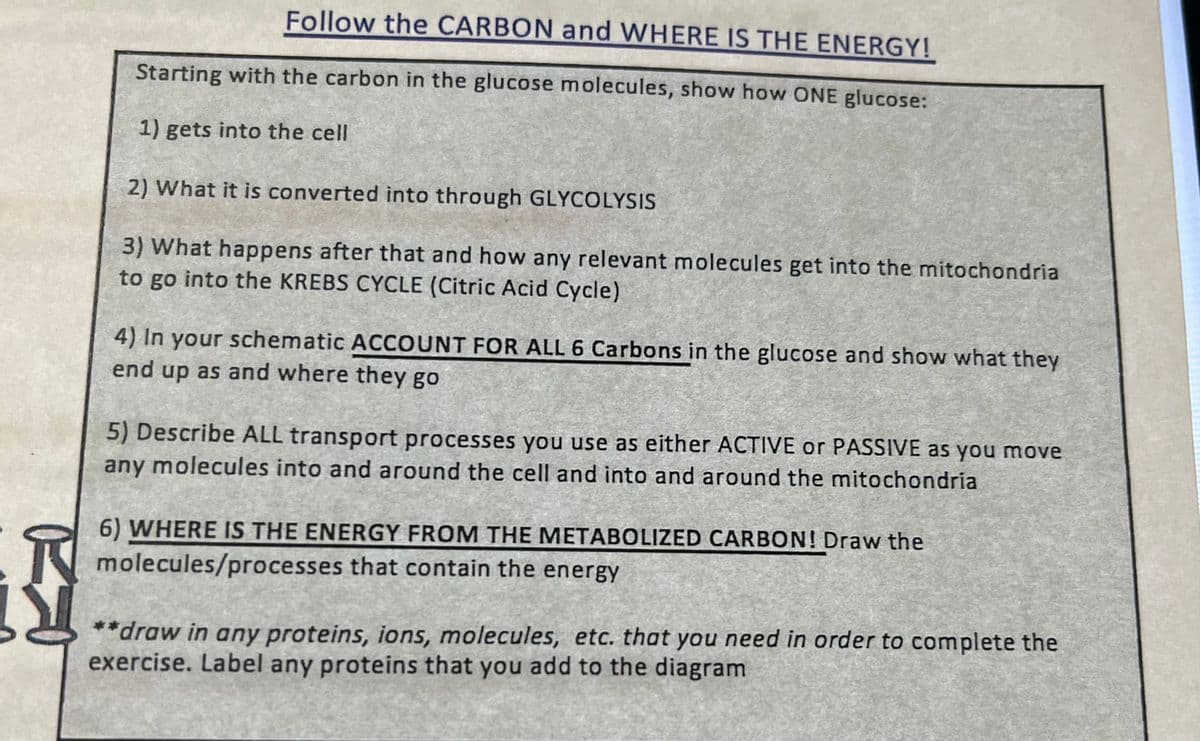Starting with the carbon in the glucose molecules, show how ONE glucose: 1) gets into the cell 2) What it is converted into through GLYCOLYSIS 3) What happens after that and how any relevant molecules get into the mitochondria to go into the KREBS CYCLE (Citric Acid Cycle) 4) In your schematic ACCOUNT FOR ALL 6 Carbons in the glucose and show what they end up as and where they go 5) Describe ALL transport processes you use as either ACTIVE or PASSIVE as you move any molecules into and around the cell and into and around the mitochondria 6) WHERE IS THE ENERGY FROM THE METABOLIZED CARBON! Draw the molecules/processes that contain the energy **draw in any proteins, ions, molecules, etc. that you need in order to complete the exercise. Label any proteins that you add to the diagram
Starting with the carbon in the glucose molecules, show how ONE glucose: 1) gets into the cell 2) What it is converted into through GLYCOLYSIS 3) What happens after that and how any relevant molecules get into the mitochondria to go into the KREBS CYCLE (Citric Acid Cycle) 4) In your schematic ACCOUNT FOR ALL 6 Carbons in the glucose and show what they end up as and where they go 5) Describe ALL transport processes you use as either ACTIVE or PASSIVE as you move any molecules into and around the cell and into and around the mitochondria 6) WHERE IS THE ENERGY FROM THE METABOLIZED CARBON! Draw the molecules/processes that contain the energy **draw in any proteins, ions, molecules, etc. that you need in order to complete the exercise. Label any proteins that you add to the diagram
Human Physiology: From Cells to Systems (MindTap Course List)
9th Edition
ISBN:9781285866932
Author:Lauralee Sherwood
Publisher:Lauralee Sherwood
Chapter2: Cell Physiology
Section: Chapter Questions
Problem 2SQE
Related questions
Question

Transcribed Image Text:Follow the CARBON and WHERE IS THE ENERGY!
Starting with the carbon in the glucose molecules, show how ONE glucose:
1) gets into the cell
2) What it is converted into through GLYCOLYSIS
3) What happens after that and how any relevant molecules get into the mitochondria
to go into the KREBS CYCLE (Citric Acid Cycle)
4) In your schematic ACCOUNT FOR ALL 6 Carbons in the glucose and show what they
end up as and where they go
5) Describe ALL transport processes you use as either ACTIVE or PASSIVE as you move
any molecules into and around the cell and into and around the mitochondria
R
6) WHERE IS THE ENERGY FROM THE METABOLIZED CARBON! Draw the
molecules/processes that contain the energy
**draw in any proteins, ions, molecules, etc. that you need in order to complete the
exercise. Label any proteins that you add to the diagram
Expert Solution
This question has been solved!
Explore an expertly crafted, step-by-step solution for a thorough understanding of key concepts.
This is a popular solution!
Trending now
This is a popular solution!
Step by step
Solved in 4 steps with 1 images

Knowledge Booster
Learn more about
Need a deep-dive on the concept behind this application? Look no further. Learn more about this topic, biology and related others by exploring similar questions and additional content below.Recommended textbooks for you

Human Physiology: From Cells to Systems (MindTap …
Biology
ISBN:
9781285866932
Author:
Lauralee Sherwood
Publisher:
Cengage Learning

Biology: The Dynamic Science (MindTap Course List)
Biology
ISBN:
9781305389892
Author:
Peter J. Russell, Paul E. Hertz, Beverly McMillan
Publisher:
Cengage Learning

Biochemistry
Biochemistry
ISBN:
9781305577206
Author:
Reginald H. Garrett, Charles M. Grisham
Publisher:
Cengage Learning

Human Physiology: From Cells to Systems (MindTap …
Biology
ISBN:
9781285866932
Author:
Lauralee Sherwood
Publisher:
Cengage Learning

Biology: The Dynamic Science (MindTap Course List)
Biology
ISBN:
9781305389892
Author:
Peter J. Russell, Paul E. Hertz, Beverly McMillan
Publisher:
Cengage Learning

Biochemistry
Biochemistry
ISBN:
9781305577206
Author:
Reginald H. Garrett, Charles M. Grisham
Publisher:
Cengage Learning

Anatomy & Physiology
Biology
ISBN:
9781938168130
Author:
Kelly A. Young, James A. Wise, Peter DeSaix, Dean H. Kruse, Brandon Poe, Eddie Johnson, Jody E. Johnson, Oksana Korol, J. Gordon Betts, Mark Womble
Publisher:
OpenStax College